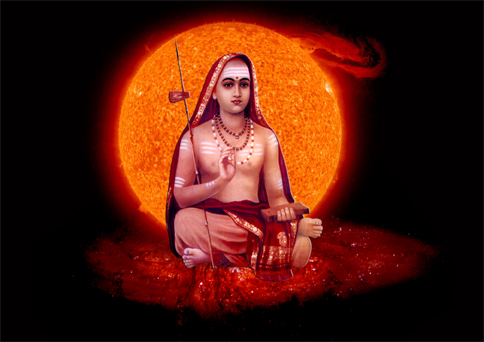Significance of Sankaracharya Jayanti

(Nation will celeberate Sri Sankara Jayanhi this year on May 15th )
Jagadguru Adi Sankaracharya was one of the greatest philosophers and savants of India. Reverently adored as the Bhagavatpada, he belongs to the galaxy of Master-Minds of the world holding a pre-eminent place among prophets and intellectuals. He is by far the most outstanding personality of all times and of all countries. He was the supreme exponent of the doctrine of Advaita Vedanta and a savior of Vedic Dharma. Acknowledged by everyone in the east and in the west, in its thoroughness and profundity, the Advaita system of Sankaracharya holds the first place among the philosophies of the world.
The word Advaita (non-dualism) essentially refers to the identity of the Self (Atman) and the Whole (Brahman). Advaita rejuvenated much of Hindu thought and also spurred debate with the two main theistic schools of Vedanta philosophy that were formalized later-Vishishtadvaita (qualified non-dualism), and Dvaita (dualism).
Though he lived for only thirty-two years, his achievement was unparalleled. Sankaracharya is said to have founded four mutts (monasteries) in the four corners of India, probably following the Buddhist vihara system. These mutts are at Sringeri (south), Puri (east), Dwaraka (west) and Badrinath (north). The establishment of these mutts was one of the significant factors in the development of his teachings into the leading philosophy of India.
Biographers narrate that Sankaracharya first went to Kasi, a city celebrated for learning and spirituality and then travelled all over India holding discussions with philosophers of different creeds. His intense debate with Mandana Misra, a philosopher of the Mimamsa school, whose wife served as an umpire, is perhaps the most interesting episode in his life. Sankaracharya propagated his teachings chiefly to sanyasins and intellectuals. Gradually, he won the respect of Brahmins and feudal lords. He enthusiastically endeavoured to restore the orthodox Brahminical tradition without paying much attention to the bhakti movement, which had made a deep impression on ordinary Hindus of his time.
There are at least 11 works that profess to be biographies of Adi Sankaracharya. All of them were composed centuries later and are filled with legendary stories and incredible anecdotes. Traditional accounts of Adi Sankaracharya’s life can be found in the Sankara Vijayams, which are poetic works that contain a mix of biographical and legendary materials, written in the epic style. The most important among these biographies are the Madhaviya Sankara Vijayam of Madhvacharya, the Cidvilasiya Sankara Vijayam of Cidvilasa and Keraliya Sankara Vijayam.
Over 300 commemorative, expository and poetical Sanskrit works are attributed to him. However, his masterpiece, Brahmasutra Bhashya is a fundamental text of the Vedanta school. His style of writing is lucid and his works are characterized by the penetrating insight and analytical skill. His approach to truth is psychological and religious rather than logical. The key source texts for all schools of Vedanta are the Prasthanatrayi-the canonical texts consisting of the Upanishads, the Bhagavad Gita and the Brahma Sutras. He also wrote Prakarana-Granthas in verse and prose varying from a single sloka to a thousand. The more important among these are the Satasloki, Sarva Vedanta Sara Sangraha, the Upadesa Sahasri and the Vivekachudamani.
It has been popularly believed that Sankaracharya was born in 788 AD into a pious Namboodiri Brahmin family in a village called Kalady in Kerala as the son of Sivaguru and Aryamba. According to lore, it was after his parents, who had been childless for many years, prayed at the Vadakkunnathan Temple, Thrissur that Sankara was born under the star Thiruvathira. According to a tradition, Lord Shiva was the family deity and that Sankara was by birth a worshipper of Shakti, the consort of Lord Shiva and female personification of divine energy. His father died when Sankara was hardly three years old. His Upanayanam, the initiation into student-life, was performed at the age of five.
As a child, Sankara showed remarkable scholarship, mastering the four Vedas by the age of eight. He renounced the world to become an ascetic against his mother’s will. Sankara then left his home and travelled towards North India in search of a guru. On the banks of the Narmada River, he met Govinda Bhagavatpada and became his disciple. The guru instructed Sankara to write a commentary on the Brahma Sutras and propagate the Advaita philosophy. Govinda Bhagavatpada was a disciple of Gaudapada, author of Mandukya-Karika, an important work on Vedanta.
Sankaracharya unified the theistic sects into a common framework and his efforts helped Hinduism regain strength and popularity. He taught the universality of the Vedic religion and his doctrines derived the main currents of modern Indian thought.Â
(The author is a freelance journalist and social activist. He can be contacted on [email protected])
Welcome to Haindava Keralam! Register for Free or Login as a privileged HK member to enjoy auto-approval of your comments and to receive periodic updates.
Latest Articles from Uncategorized
- Comrades, Is this the revolution?
- Maradu Hindu massacre – Never to Forget.
- Ramayana, To Echo from Haindava Homes
- Significance of Sankaracharya Jayanti
- Ramayana, To Echo from Haindava Homes
- MARTYR JAYAKRISHNAN MASTER LIVES IN THE HEARTS OF THOUSANDS HE LEFT BEHIND
- HAINDAVA KERALAM 6th ANNIVERSARY
- WHAT REALLY HAPPENS INSIDE A CATHOLIC CHURCH?
- VOTE FOR HINDUTVA – VIDEOS
- SABARIMALA – STOP THIS LOOT AND DISCRIMINATION


Responses